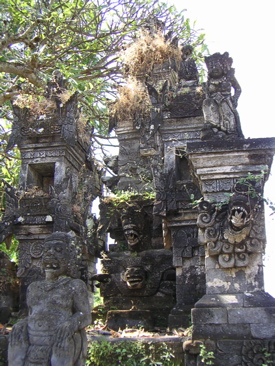Hindu´sm
Balinese Hinduism (Agama Hindu Dharma or Agama Hindu Bali) is the second religion in Indonesia. 90% of Bali’s inhibitants are Hindu. This religion is not tob e compared to the Hinduism of India or with the historic Javanese-Hindu religion although these two elements together with Buddhism are the base of the complex Hindu religion of Bali.
Agama Hindu Dharma, has five principles, the ‘panca srada’:
1. the blief in ‘Sanghyang Widhi Wasa’, the one and only God
2. the belief in ‘Atman’, the eternal soul
3. the belief in ‘Kharma Pala’, the law of cause and consequence
4. the belief in ‘Punarbhawa’, reincarnation.
5. the belief in ‘Moksha’, the unification with the Eternal Spirit.
Travelling through Bali the many temples and shrines gives you the impression that many different Gods or spirits are worshipped. In fact they are all the different manifestations of the ‘trimurti’, de unity of Brahma the creator, Visnu the keeper and Siwa the destroyer. This tree-unity is united in one God: Sang Hyang Tunggal, “the highest, the purest”, which can be manifested in different ways. The many Gods and Goddesses are aspects of ‘the highest, purest’ or “the one and only”. The centre or religion is the ‘pura desa’, where Brahman priests execute the most important ceremonies. Besides these main temple there are thousands of other temples, where as temples devoted to the deaths, family temples and temples at every house.
In Bali always somewhere there will be temple celebration or religious ceremony. Important is the big temple celebration or ‘odalan’, held in every village and remembers the founding of the temple. The date of celebration is calculated according to the Balinese calender, based on the ‘wuku-’ of moon year.
The most ‘spectacular’ ceremony to witness is the burning of the deceased or ‘ngabŔn’. This is not a very sad event, because generally the person who is to be cremated often has past away months or years ago and is first buried awaiting the family savings to be able to pay and arrange this final ceremony. Through cremation the soul will be liberated to reach heaven.
The size of the tower which carry the corpse depends on the caste and wealth of the deceased. The tower represents the cosmos. A turtle winded by snakes (naga) forms the base, on top a platform carries the deceased. In this way the body is positioned between heaven and earth.
The differences with the cremation rituals in India are remarkable. In India these are quite simple ceremonies, where on Bali on the contrary burial events are surrounded with many ceremonies or rituals.
Animated nature
The influence of the traditional (animistic) religion can not be discarded. Many Indonesian people still value elements from the old community religions, even when converted to the main religions. The authentic religions know many difference but one element they all have in common, the belief that nature or manmade objects are animated.. Specially old trees, mountains, caves and springs are favourite places for the spirits to live in. This can be nature spirits, but also a deity or the spirits of the deaths. In the traditional Indonesian religions the belief in an animated nature is often seen together with ancestor worshipping. It is generally believed that the spirits of the death influence daily living. Therefore the soul of a relative who past away has to be managed or surrounded with care. During rituals gifted people arrange the contact between the human and the spiritual world These (and other) rituals are the glue of the (traditional) community.
